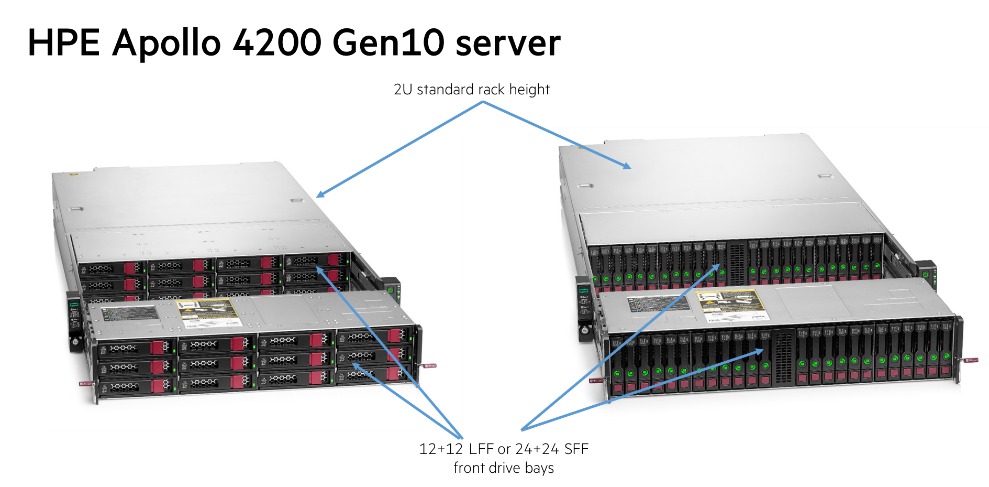Our solution engineers are constantly configuring, testing, benchmarking and documenting our Microsoft solutions, providing vital guidance to our customers and resellers so that they can quickly and confidently deploy them. I had a moment to go back over some recent work we did on our Microsoft Exchange Solution, and I wanted to share some highlights that can be missed if you didn’t have the time to read through these detailed technical publications.
The widening orbit of Apollo
First off, the HPE Apollo 4200 Gen10 has been our go-to Storage server for some time. A key offering in the HPE Storage product line, it serves as the company’s lead platform for Software-defined storage solutions. It shares a heritage with the Apollo HPC compute systems (e.g. model 2000s, 6000s) around HPC storage and big-data usage. Storage use evolved to include object storage, scale-out file systems, backup, archive and other data-intensive workloads. Of course Microsoft Exchange is the grand-daddy of business email, a classic data-intensive application, esp. if you’re regularly sharing multi-MB sized powerpoints.
As we continue to build-out our Microsoft solution business, we’ve hit upon a powerful use scenario for Apollo as a leading platform for Azure Stack HCI. You’ll continue to see more news and innovation coming from us in this area in the coming months.

HPE Apollo 4200 Gen10 server with Exchange 2016 ESRP
Our team undertook testing based on Microsoft’s testing benchmark/certification known as the Exchange Solution Reviewed Program. The program combines a storage testing harness (Jetstress) with solution publishing guidelines, and has been used by Storage OEMs for over the past decade as a standard testing framework. Customers and resellers have been eager consumers of the publications as a way to compare results across vendors and to help design their Exchange storage architectures and deployments.
This specific testing used the HPE Apollo 4200 Gen10 storage system, which is a 2U server available either in a 24 large form-factor (LFF) drive configuration or a 48 small form-factor (SFF) drive configuration.
The remarkable feature of the 4200 is that the drive cages use two trays, with the second tray accessed by simply pulling the front tray forward on internal rails and can be done while the server is operational. This unique chassis design produces probably the highest storage density available in a 2U server in the industry.
The bigger brains of the Apollo 4200 Gen10
The HPE Apollo 4200 Gen10 contains 16 DIMM slots, which support up to 1TB RDIMM (registered) or 2TB of LRDIMM (Load reduced) memory. Individual DIMM capacity has doubled in this latest platform update, going from 32GB to 64GB RDIMMs and 64GB to 128GB LRDIMMs.
The CPUs have been upgraded to use next-gen Intel® Xeon® Scalable processors, the same ones designed for AI/Deep learning workloads, and future-proofed with support for Intel Optane PMEM. The upgraded CPU enables an increase from 24 cores to 28 cores and with the clock speed increasing from 2.1 to 2.3GHz.
There are 5 PCIe slots accessible from the rear of the unit. The 16x slots support 100Gbe Ethernet connections, and the 24x slots support up to 6 NVMe SSDs.
Get flexible with the Apollo
Another feature of the HPE Apollo 4200 Gen 10 is its flexibility. Multiple configurations are possible, depending on capacity and performance needs, making this a valuable platform for Exchange deployments of any size.
The rear drive cage alone can be re-configured in a number of ways:
- Five low-profile PCIe slots with two processors
- Or, Four LFF rear drive cages, along with the Five low-profile PCIe slots with two processors
- Or, Two SFF rear drive cages + two full-height half-length risers, and the Five low profile PCIe slots with two processors
- Or, Six SFF rear NVMe cages, along with the Five low-profile PCIe slots with two processors
The Ultimate Exchange Building Block
This HPE solution for Microsoft Exchange Server 2016 was designed using a building block approach, with a multi-copy database design using Exchange Database Availability Groups (DAGs). A DAG is a group of up to 16 mailbox servers that host a set of databases, providing automatic recovery from failures that affect databases or individual servers.

This solution used a single DAG in two building blocks, which are two servers in the primary site and two servers in the secondary site, to support 4,000 mailboxes per building block with a 25 GB capacity, and a messaging profile of 200 messages sent and received per user, per day. Using the building block approach, customers can scale their Exchange environment to a size that fits their needs.
The Microsoft Jetstress testing validated that the storage subsystem was capable of the IOPS needed to support the configured number of mailboxes as well as providing additional headroom for growth.
Where to get the rest of the story
The HPE Apollo 4200 Gen10 with Exchange 2016 ESRP document is available online today. Entitled, “HPE Apollo 4200 Gen10 Server 4000 mailbox resiliency Microsoft Exchange 2016 using 8 TB 7.2K large form factor drives”, it is based on Microsoft’s ESRP 4.0 testing framework. The technical whitepaper contains details on the tested performance results, configuration best practices, product photos, and includes extensive Jetstress output.
The document can be downloaded here.